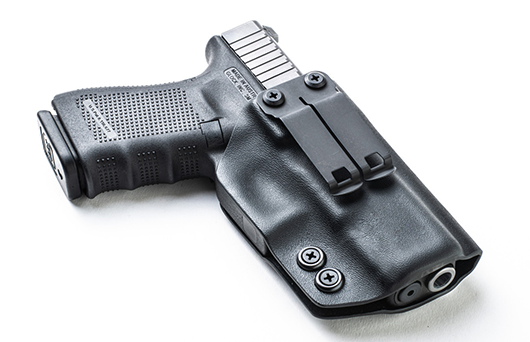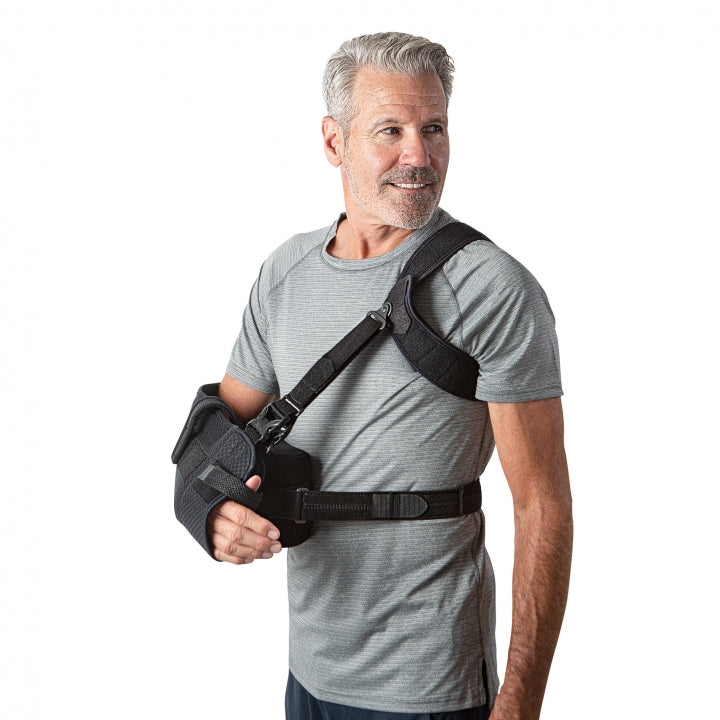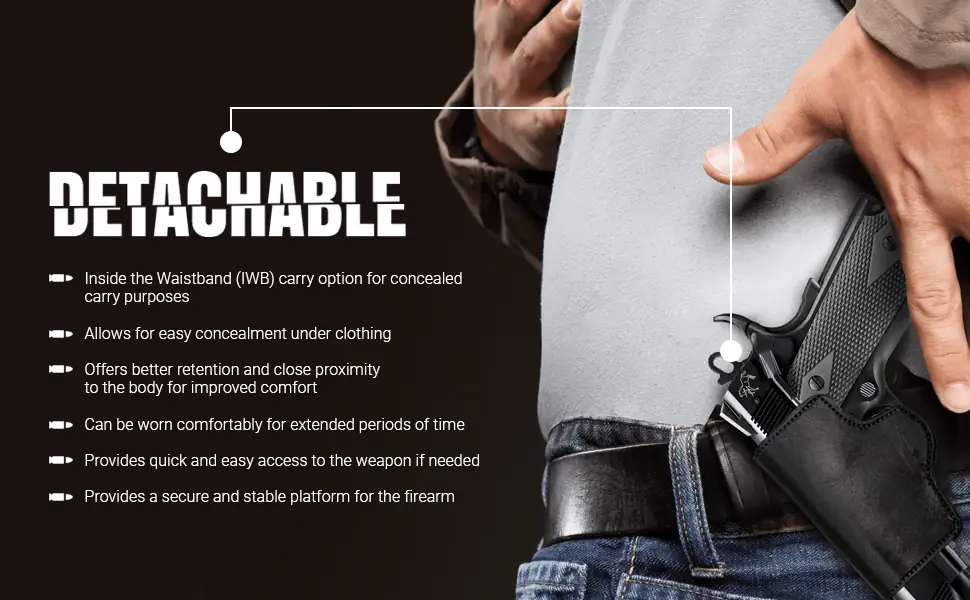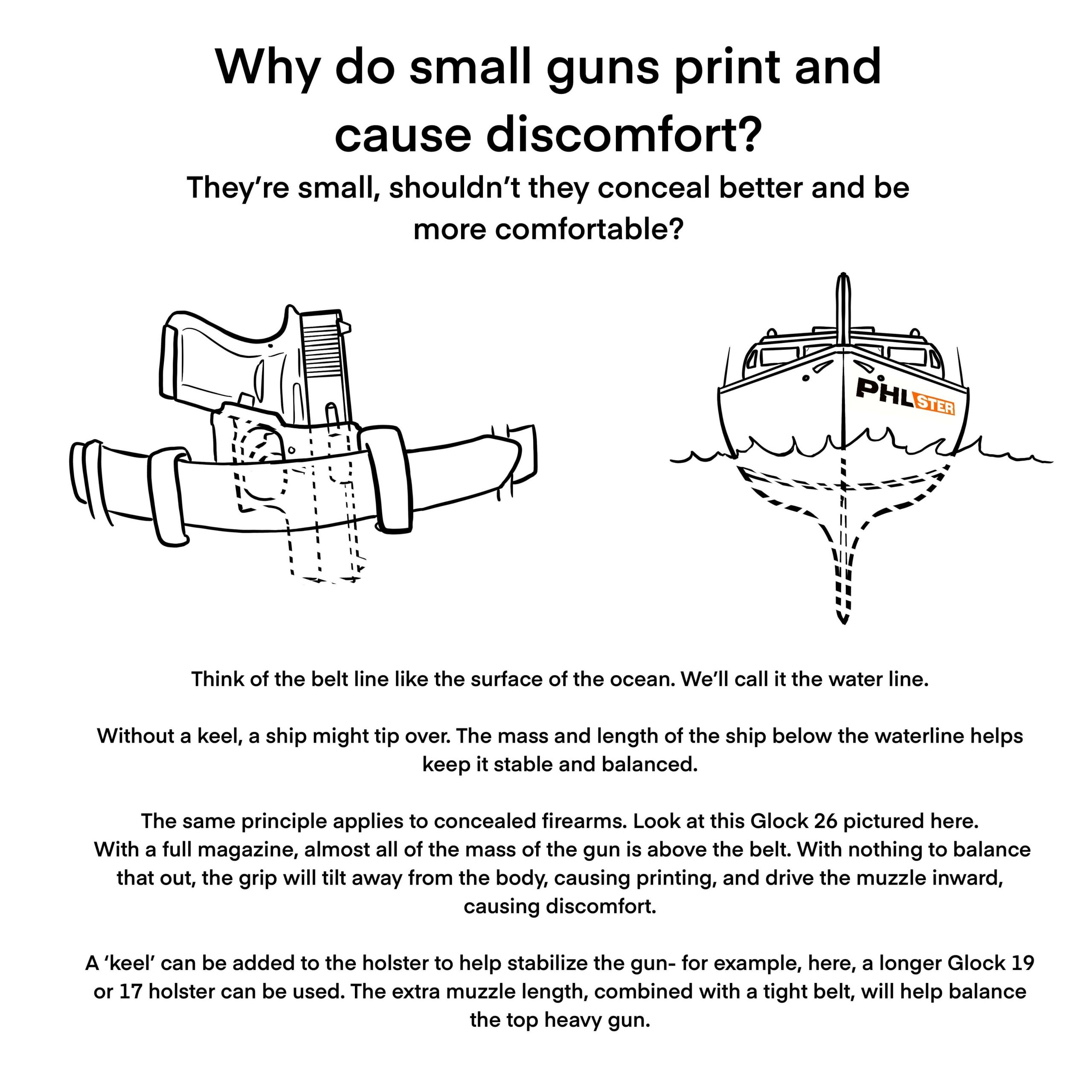Contents
- I. Introduction to Improving Holster Comfort
- II. Understanding the Importance of Holster Comfort
- III. Factors Affecting Holster Comfort
- IV. Tips for Choosing the Right Holster for Comfort
- V. Proper Holster Placement for Enhanced Comfort
- VI. Enhancing Holster Comfort with Padding and Backing
- VII. Adjusting Holster Retention for Comfortable Carry
- VIII. Holster Materials and Their Impact on Comfort
- IX. Maintaining Holster Comfort for Long-Term Use
I. Introduction to Improving Holster Comfort

When it comes to carrying a firearm, comfort is of utmost importance. An uncomfortable holster can not only be distracting but also lead to poor weapon retention and accessibility. Whether you are an experienced gun owner or a rookie, finding ways to improve holster comfort should be a top priority.
In this article, we will explore various tips and tricks that can help enhance the comfort of your holster. From adjusting the fit of your holster to choosing the right material, these strategies will ensure that carrying your firearm becomes a seamless and comfortable experience.
The Importance of Proper Holster Fit
A well-fitting holster is the foundation for achieving optimal comfort. It should securely hold your firearm in place while allowing for quick and easy access when needed. The key here is striking the right balance between retention and ease of draw.
One way to achieve this balance is by selecting a holster specifically designed for your firearm model. Many manufacturers offer holsters molded precisely for popular gun models, ensuring a snug fit that minimizes unnecessary movement during daily activities.
Choosing the Right Material
The material from which your holster is made plays a significant role in its overall comfort level. While leather has long been favored for its durability and classic appeal, modern materials such as Kydex or injection-molded polymers are gaining popularity due to their lightweight nature and superior retention capabilities.
Kydex holsters provide excellent trigger guard coverage while offering enhanced customization options like adjustable cant angles or retention levels according to personal preferences.
Finding Your Optimal Carry Position
Your body shape and size influence where you carry your firearm most comfortably. Experimenting with different carry positions can help you identify what works best for you personally.
Common carry positions include appendix carry (AIWB), strong-side hip carry, small of back, and cross-draw. Each position has its pros and cons in terms of accessibility, concealment, and comfort. It is crucial to find the one that suits your body type and daily activities.
Using Holster Accessories
Various holster accessories can significantly improve comfort levels during extended periods of carrying. Adding a padded backing or utilizing an ergonomic waistband can distribute the weight more evenly across your body, reducing pressure points.
In addition to these accessories, using a sturdy belt with sufficient thickness and rigidity will prevent sagging or shifting of the holster as you move throughout the day.
By employing these tips and tricks for improving holster comfort, you can ensure that carrying your firearm becomes a seamless part of your routine. Remember to prioritize proper fit, choose the right material for your needs, experiment with different carry positions based on your physique, and invest in additional accessories if necessary. With these adjustments in place, you will experience enhanced comfort without compromising on safety or accessibility.
II. Understanding the Importance of Holster Comfort

When it comes to carrying a firearm, comfort should never be compromised. The way you carry your weapon can greatly impact your overall experience, and finding a holster that provides optimal comfort is essential for both safety and convenience.
The Role of Holster Comfort
A comfortable holster allows for extended periods of wear without causing discomfort or irritation. It ensures that the weight of the firearm is distributed evenly, reducing strain on specific areas of the body. Moreover, a well-fitting and comfortable holster also promotes proper concealment while allowing quick and easy access to your weapon when needed.
The Impact on Daily Activities
Wearing an uncomfortable holster can restrict your movements and limit your ability to perform daily activities comfortably. Whether you’re sitting at a desk all day or engaged in physical tasks, an ill-fitting or poorly designed holster can become a constant distraction and hinder productivity. On the other hand, with a comfortable holster, you’ll have freedom of movement without compromising safety.
Finding the Right Material
The material used in creating holsters plays a significant role in determining their comfort levels. Soft yet durable materials like leather or neoprene are popular choices as they conform to the body shape over time while providing cushioning against pressure points. Additionally, these materials often offer moisture-wicking properties which prevent sweat buildup and enhance overall comfort.
Proper Fit Matters
A properly fitting holster ensures maximum comfort by securely holding your firearm in place while minimizing unnecessary movements or adjustments throughout the day. It’s crucial to choose holsters specifically designed for your make and model of firearm to ensure an accurate fit that eliminates any potential discomfort caused by loose fits or rubbing against exposed areas.
Adjustability for Individual Preference
Every individual’s body shape and preference are unique, so it’s important to select a holster that offers adjustability. Adjustable holsters allow you to find the perfect position and angle of carry, ensuring optimal comfort while accommodating various clothing choices or carrying positions.
The Importance of Holster Comfort for Everyday Carry
For those who carry firearms daily, having a comfortable holster is crucial. It enables you to go about your day with confidence, knowing that your weapon is secure yet easily accessible when required. By prioritizing comfort in your choice of holsters, you can enhance both safety and peace of mind throughout each day.
III. Factors Affecting Holster Comfort

When it comes to choosing a holster, comfort is paramount. After all, you want to be able to wear your firearm without any discomfort or irritation. Here are some key factors that can greatly affect the comfort of your holster:
The Material
The type of material used in a holster plays a significant role in its overall comfort. Common materials include leather, Kydex, nylon, and hybrid combinations of these materials. Leather holsters are known for their softness and flexibility, conforming to the shape of your body over time for a custom fit. Kydex holsters offer excellent retention and durability but may lack the same level of initial comfort as leather options.
The Design
Another factor influencing holster comfort is its design. Some holsters feature adjustable cant angles or ride heights which allow you to find the most comfortable position for drawing and carrying your firearm. Additionally, certain designs incorporate padding or cushioning in strategic areas to minimize pressure points and enhance overall comfort.
Belt Attachments
The method by which the holster attaches to your belt also affects its comfort level. Different belt attachments such as loops, clips, or paddles provide varying levels of stability and ease of use. It’s essential to find a belt attachment style that not only securely holds the holster but also doesn’t dig into your skin or cause discomfort during extended periods of wear.
Retention System
A well-designed retention system ensures that your firearm stays securely in place while allowing for quick and smooth draws when needed. However, an overly tight retention system can cause discomfort by putting excessive pressure on certain areas or making it difficult to draw smoothly.
Body Shape and Size
Your unique body shape and size can significantly impact the comfort of a holster. What works well for one person may not suit another due to differences in body proportions or clothing choices. It’s crucial to consider your body type and how the holster will interact with your clothing when making a selection.
By taking these factors into account, you can make an informed decision when choosing a holster that prioritizes comfort without compromising on functionality or safety.
IV. Tips for Choosing the Right Holster for Comfort

When it comes to choosing a holster that offers both functionality and comfort, there are several factors to consider. Here are some tips to help you find the perfect holster:
1. Material Matters
One of the most important aspects of a comfortable holster is the material it’s made from. Look for holsters crafted from high-quality materials like leather or Kydex, as they provide durability and flexibility.
2. Consider Your Preferred Carry Position
The right holster should accommodate your preferred carry position. Whether you prefer appendix carry, strong-side hip carry, or small-of-back carry, make sure the holster allows for a secure fit in that position.
3. Retention Mechanism
The retention mechanism is another crucial aspect to consider when selecting a comfortable holster. Look for one with an adjustable retention system that allows you to customize the level of tightness around your firearm.
4. Size and Weight Distribution
A well-designed holster will distribute the weight of your firearm evenly to prevent discomfort during extended periods of wear. Opt for holsters with wider straps or additional padding if necessary.
5. Concealability
If concealment is important to you, choose a holster that provides adequate coverage without printing through clothing or causing excessive bulges on your body.
6. Adjustable Cant Angle
An adjustable cant angle allows you to adjust how your firearm sits in relation to your body’s natural contours and movements, increasing both comfort and accessibility.
7. Sweat Resistance
Sweat can quickly make wearing a concealed carry uncomfortable if not properly managed. Look for holsters with moisture-wicking properties or sweat guards to prevent moisture build-up and skin irritation.
8. Test It Out
The best way to determine the comfort of a holster is by trying it out before making a purchase. If possible, visit a local gun store or shooting range that allows you to test different holsters with your firearm to find the one that feels most comfortable for you.
By considering these tips when choosing your holster, you can ensure both comfort and functionality while carrying your firearm discreetly and securely.
V. Proper Holster Placement for Enhanced Comfort

When it comes to carrying a firearm, comfort is key. The placement of your holster plays a crucial role in ensuring that you can carry your weapon comfortably and without any unnecessary discomfort. Here are some tips on how to properly position your holster for enhanced comfort:
1. Find the Right Spot
The first step is to find the right spot on your body where you want to carry your firearm. This will largely depend on personal preference and body type. Common areas include the waistline, hip, appendix, or small of the back.
2. Consider Accessibility
While comfort is important, it’s equally vital to consider accessibility when placing your holster. You’ll want to ensure that you can easily draw your weapon when needed without any hindrances or delays.
3. Experiment with Angles
The angle at which you wear your holster can greatly impact both comfort and accessibility. Some individuals prefer a straight-up-and-down position while others find an angled position more comfortable.
4. Adjust Tightness
The tightness of the holster also affects its placement and overall comfort level. It should be snug enough to hold the firearm securely in place but not overly tight so as to cause discomfort or restrict movement.
5. Mind Your Clothing Choice
The type of clothing you wear can influence how well the holster sits against your body and consequently impact comfort levels significantly. Opt for looser-fitting clothing or consider investing in holsters designed specifically for concealed carry purposes if necessary.
By following these tips, you’ll be able to find proper holster placement that enhances both comfort and accessibility while carrying a firearm.
Remember, finding the right placement may require some trial and error. Take the time to experiment with different positions until you find what works best for you. Comfort is essential when it comes to carrying a weapon, so don’t hesitate to make adjustments as needed. Happy and safe carrying!
VI. Enhancing Holster Comfort with Padding and Backing
When it comes to holster comfort, one of the most effective ways to improve your experience is by adding padding and backing. These simple modifications can make a world of difference in terms of comfort, fit, and overall satisfaction.
Addition of Foam Padding
An easy way to enhance the comfort level of your holster is by incorporating foam padding. This extra layer not only provides cushioning but also helps distribute the weight evenly across your body. By reducing pressure points and preventing chafing, foam padding ensures that you can wear your holster for extended periods without discomfort.
Utilizing Soft Neoprene Backing
If you find that your current holster causes irritation or rubs against your skin, consider using soft neoprene backing as an alternative. Neoprene is a durable material known for its flexibility and moisture-wicking properties. By attaching a neoprene backing to the backside of your holster, you create a barrier between the rough edges and sensitive areas on your body.
Adjustable Straps for Custom Fit
To further optimize the comfort level provided by padding and backing, ensure that you have adjustable straps on your holster. Not everyone’s body shape is the same, so having straps that can be customized according to personal preferences ensures a snug fit without compromising on comfort.
Breathable Fabrics for Ventilation
In hot or humid climates, wearing a holstered firearm can become uncomfortable due to excess sweating or heat buildup. Choosing holsters made from breathable fabrics such as mesh or perforated materials allows air circulation around the area covered by the holster, keeping it cool and ventilated even during extended wear.
Evaluating Weight Distribution
Another aspect to consider when enhancing holster comfort is the distribution of weight. If your holster tends to pull or sag in one direction, it can lead to discomfort and strain on specific areas of your body. Opt for holsters that distribute the weight evenly, reducing any potential strain and ensuring a more comfortable experience overall.
By taking these steps to enhance holster comfort through padding and backing, you can enjoy a more pleasant carrying experience without compromising on functionality or safety. Remember, finding the right balance between comfort and practicality is crucial when selecting a holster that suits your needs.
VII. Adjusting Holster Retention for Comfortable Carry
When it comes to carrying a firearm, comfort is paramount. Ensuring that your holster provides the right level of retention can greatly enhance your overall carrying experience. Here are some tips and tricks for adjusting holster retention to achieve a comfortable carry:
1. Finding the Sweet Spot
The first step in adjusting holster retention is finding the sweet spot where your firearm stays securely in place without being too difficult to draw. Start by tightening the retention screws gradually until you feel the desired level of tension.
2. Loosening Retention for Ease of Draw
If drawing your firearm feels cumbersome or sluggish, consider loosening the retention slightly. This will allow for a smoother and quicker draw when needed while still maintaining adequate security.
3. Tightening Retention for Enhanced Security
If you prioritize maximum security over ease of draw, tightening the retention screws can provide greater peace of mind knowing that your firearm will stay firmly in place even during vigorous movements or unexpected situations.
4. Testing and Adjusting Incrementally
To find the perfect balance between comfort and security, it’s important to test different levels of retention adjustment incrementally. Make small adjustments at a time, testing each setting thoroughly before making further changes.
5. Considering Different Carrying Positions
The position at which you carry your firearm may also impact how much retention adjustment is necessary for optimal comfort and accessibility. Experiment with different positions such as appendix carry, strong-side hip carry, or small-of-back carry to determine what works best for you.
6. Training with Your Adjusted Holster
No matter how well-adjusted your holster is, it’s crucial to practice drawing and re-holstering your firearm regularly. This will help you become familiar with the adjusted retention level and ensure that you can perform these actions confidently and efficiently when it matters most.
By taking the time to adjust your holster retention properly, you can achieve a comfortable carry without compromising on safety or accessibility. Remember to always prioritize practicing safe handling techniques and consult with professionals if you have any concerns or questions.
VIII. Holster Materials and Their Impact on Comfort
When it comes to choosing a holster, comfort is a crucial factor that should not be overlooked. The materials used in the construction of the holster play a significant role in determining how comfortable it will be to wear throughout the day. Let’s explore some common holster materials and their impact on comfort.
1. Leather
Leather holsters are widely popular due to their durability and classic appearance. They offer a great balance between comfort and functionality. The natural flexibility of leather allows it to conform to your body shape over time, providing a custom fit that enhances comfort during extended wear.
2. Kydex
Kydex holsters are made from a type of thermoplastic material known for its rigidity and strength. While they may initially feel stiff, Kydex holsters gradually soften with use as they mold to the shape of your firearm. This customizable feature ensures optimal comfort while maintaining excellent retention for secure gun storage.
3. Nylon
Nylon holsters are lightweight, affordable, and suitable for various carrying positions due to their adjustable straps or clips. Although nylon may lack the same level of durability as leather or Kydex, it offers superior breathability, preventing excessive sweat buildup during warm weather conditions.
4. Neoprene
If you prioritize cushioning and moisture-wicking properties in your holster material choice, neoprene is an excellent option for you. Neoprene holsters provide exceptional padding against skin irritation while effectively managing sweat accumulation through its moisture-resistant properties.
5. Hybrid Materials
Sometimes combining different materials can result in even greater levels of comfort without compromising functionality or safety features like trigger guard protection. Hybrid holsters, such as those made from leather and Kydex or nylon and neoprene, can offer the best of both worlds by leveraging the unique benefits of each material.
When selecting a holster material for optimal comfort, it’s essential to consider your personal preferences, body shape, carrying style, and climate conditions you’ll be in. Experimenting with different materials can help you find the perfect balance between comfort and reliability while ensuring quick access to your firearm when needed.
IX. Maintaining Holster Comfort for Long-Term Use
Maintaining holster comfort is crucial, especially if you rely on your holster for long hours every day. Here are some tips to ensure that you can wear your holster comfortably over extended periods:
1. Choose the Right Holster Material
The material of your holster plays a significant role in determining its comfort level. Opt for holsters made from soft and breathable materials like neoprene or padded nylon. These materials offer better airflow, minimizing sweat build-up and discomfort.
2. Properly Adjust Your Holster
A well-adjusted holster will sit securely and comfortably on your body. Take the time to adjust the straps or belt loops according to your preference and body shape. Ensure that the holster is snug but not overly tight, allowing freedom of movement while maintaining a secure fit.
3. Consider Sweat-Wicking Features
Sweat can accumulate inside the holster during hot weather or physical activities, leading to discomfort and potential skin irritation. Look for holsters with built-in sweat-wicking features or consider using moisture-wicking inserts to keep yourself dry and comfortable.
4. Practice Regular Cleaning and Maintenance
A clean and well-maintained holster will provide better comfort in the long run. Regularly clean off dirt, debris, or sweat residue from both the interior and exterior of your holster using mild soap or specialized cleaning solutions recommended by the manufacturer.
5. Wear an Undershirt as a Barrier
If you find that direct contact between your skin and the holster causes discomfort, wearing an undershirt can act as a barrier while improving overall comfortability.
6.Use Skin-Safe Lubricants
To reduce friction and improve comfort, consider applying a small amount of skin-safe lubricant on contact points between your body and the holster. Be cautious not to use too much as it may affect the stability of the holster.
7. Take Regular Breaks
If you wear your holster for extended periods, it’s essential to take regular breaks to allow your body some relief. This will help prevent discomfort or any potential issues that may arise from prolonged use.
8. Consider Holster Cushioning Accessories
If you’re still experiencing discomfort, consider investing in cushioning accessories specifically designed for holsters. These can provide additional padding or ergonomic support to enhance overall comfort during extended wear.
By following these tips, you can ensure that wearing your holster remains comfortable even during long-term use. Remember that comfort is key when it comes to holsters, as it directly affects both performance and everyday carry experience.

Brian Belko is a freelance writer and blogger. His primary areas of focus include the outdoors and shooting sports. In addition to his freelance work, Brian also writes for Wide Open Spaces and is on the Pro Staff at Military Hunting and Fishing. When he isn’t busy writing, Brian enjoys fishing farm ponds for bass and hitting the spring woods during turkey season.
